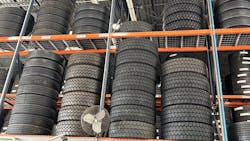Retail sellout trends in December turned positive, with dealers seeing retail unit sales growing 1.1% year-over-year in the month, following a flat November. It was far from robust, but just three of the twelve months in 2023 saw positive sellout trends, thus the December result is an improvement compared to the majority of the year.
Regionally, the Southeast saw the strongest trends, up double-digits compared to a year ago. Based on feedback from the dealer community, it appears the positive momentum in December was mainly due to outsized results from the Southeast region, as several industry contacts indicated sales were slow for the time of year — given a mild winter.
The consumer trade-down dynamic continued in December as dealers which saw the most positive momentum indicated it was due to higher sales of tier-two and tier-three tires. We have long felt that last year’s “green winter” may provide a catchup period for replacement tire sellout. Given this, we would not be surprised to see sellout levels in January on the positive side of the ledger, with a continued shift to lower-tier brands.
Miles driven trends were again positive in December, with our miles driven momentum index registering a 1.8% increase year-over-year, and that follows a 2% gain in November. For the year as a whole, eight out of 12 months had positive miles driven gains in 2023, an improvement from the lackluster 2022. From our view, the tire replacement industry and broader automotive aftermarket are seeing a healthier backdrop compared to this time a year ago.
Outlook on tire prices
In aggregate in 2023, our tire raw material index fell 9.7% from 2022 levels, though with the lapping of price declines on the horizon we expect the rate of decline to continue to diminish as we move forward. And it is notable, in analyzing specific input costs, that natural rubber prices climbed 14.5% during the fourth quarter due to heavy rainfall in Southeast Asia that put pressure on supply. Carbon black prices also increased during the quarter, while oil, synthetic rubber and tire fabric and cord prices fell. With a level of stability in raw material prices and waning demand for premium tire tiers, we wonder if an incremental price concession could be on the horizon from premium tire manufacturers.
However, our surveys continue to point towards a level of stickiness regarding upper-tier tire prices. That said, we do see the potential for price decreases at some point in 2024 as raw material costs continue to cool, inventory levels appear to be more normalized at this time, and manufacturers may concede some price in order to encourage wholesalers to begin taking on more inventory.
Low price leaders
Despite positive volume trends, dealer commentary suggests consumer demand for passenger and light truck replacement tires was negative on a net basis, compared to December 2022. One out of four of our dealer contacts saw negative demand trends in December, down from the 10% who reported downward trends in November. Dealer feedback indicates the bulk of consumer demand in December was in lower-priced categories.
We continue to believe there is a hidden level of pent-up demand in the tire replacement market due to snowfall a year ago being consolidated into a few big storms, which shortened the window for weather-related tire purchases. We still see a scenario in which demand returns to positive territory as vehicle owners pursue needed maintenance as winter weather arrives.
Mixed trends
Our dealer survey indicated tier-two brands were the most in-demand, and we continue to see tier-two and their-three tires swapping places month after month at the top of the chart, while tier-one tires remain in last place in our rankings for the third straight month. One dealer told us he believes the shift away from the top tier will continue in 2024.
Given the elevated prices that remain for premium brands and the inflationary environment that is stretching consumers’ wallets, it seems logical consumers continue to trade down. Longer term, we continue to believe that consumers will opt for tier-two tires as a balance of cost and performance.
About the Author

John Healy
John Healy is a managing director and research analyst with Northcoast Research Holdings LLC, based in Cleveland, Ohio. Healy covers a variety of subsectors of the automotive industry and writes MTD's monthly Your Marketplace column. If you would like to be included in the monthly dealer discussions, contact him at [email protected].
